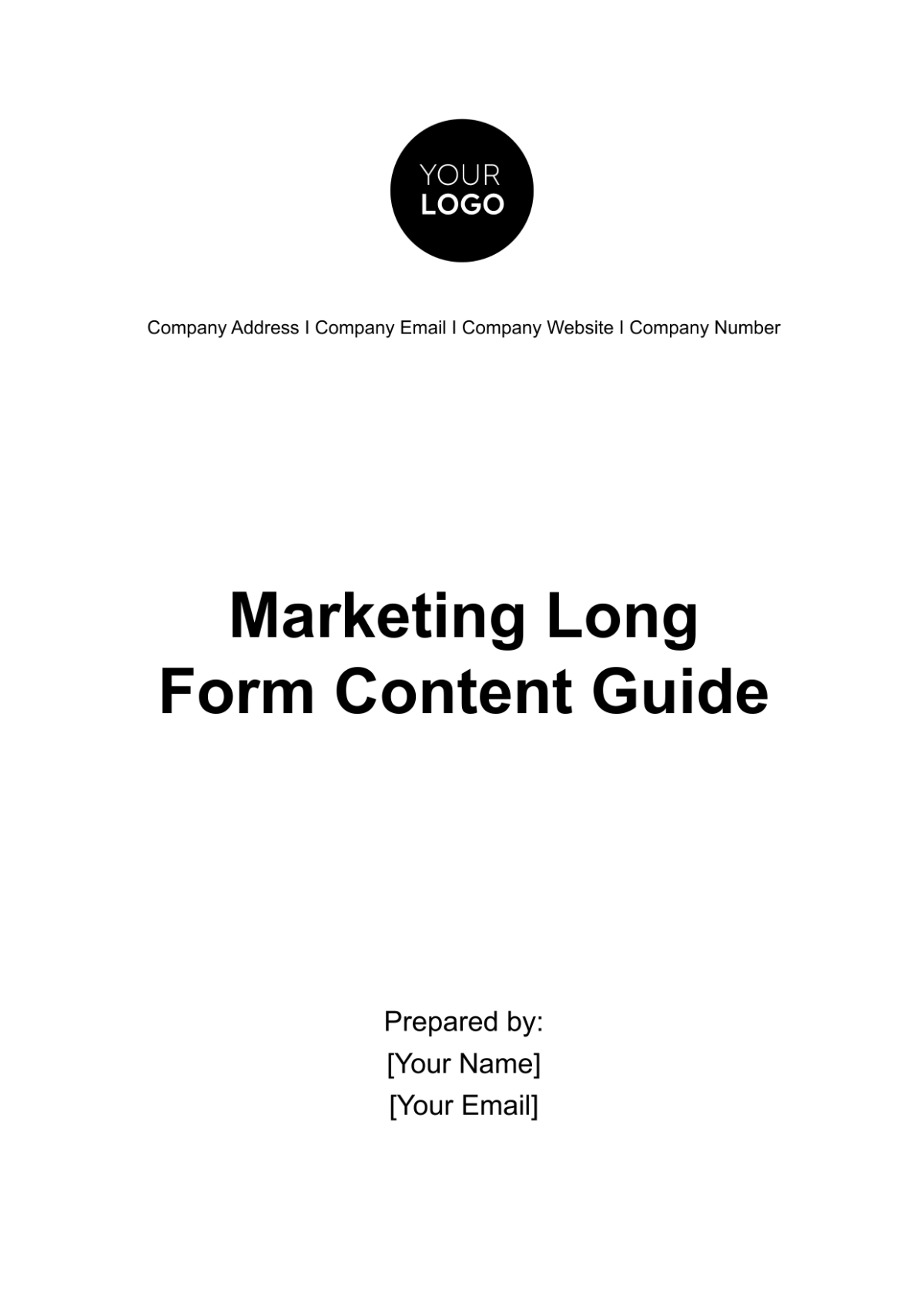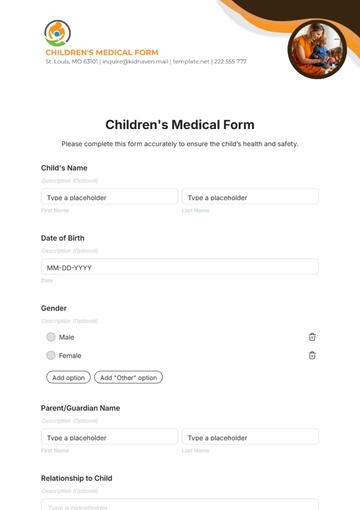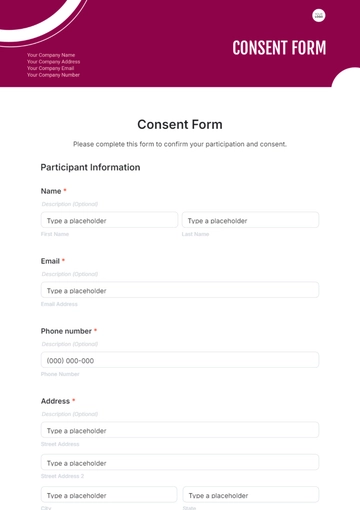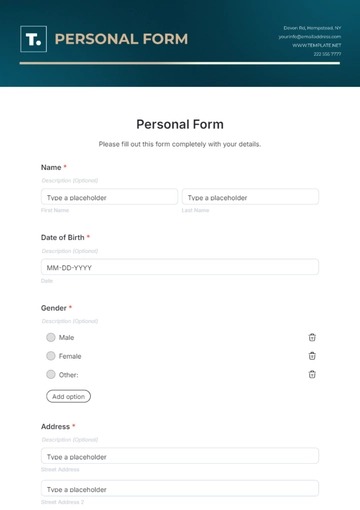Free Marketing Long-form Content Guide

I. Introduction to Long-form Content Marketing
In the ever-evolving digital landscape, the adage "content is king" remains resolute. However, as attention spans dwindle and information overload becomes the norm, the form and substance of content have undergone a profound transformation. Welcome to the world of Long-form Content Marketing, where depth, authority, and engagement reign supreme.
A. Definition and Purpose of Long-form Content
Long-form content isn't merely about word count; it's a commitment to providing an immersive and informative experience. It encompasses in-depth, well-researched pieces that often exceed 1,000 words. The primary purpose? To not just inform but to educate, to not just engage but to establish unassailable authority in a particular subject area.
Statistical data and research findings underscore its significance. According to a study by HubSpot, articles exceeding 2,000 words receive, on average, 300% more social shares than their shorter counterparts. Furthermore, they tend to earn more backlinks, boosting SEO rankings and amplifying brand visibility.
B. Benefits of Long-form Content
Long-form content is the bridge to Thought Leadership. It allows us to showcase our expertise, nurturing trust and credibility within our industry. It's a powerful vessel for targeted keyword optimization, enhancing our search engine rankings and organic traffic.
But its benefits extend beyond SEO. Longer pieces can captivate readers, immersing them in a comprehensive narrative that keeps them on our website longer, nurturing brand loyalty and trust. The extended format also proves invaluable for Lead Generation, as readers are more willing to exchange their contact information for the promise of valuable insights.
C. Target Audience and Goals
The effectiveness of long-form content hinges on understanding your audience inside-out. Dive deep into their interests, pinpoint their pain points, and discern their information needs. Each piece should have a clear purpose, whether it's lead generation, brand awareness, or positioning yourself as an industry luminary.
D. Role of Long-form Content in the Marketing Strategy
Long-form content isn't an isolated endeavor; it's a critical cog in the machinery of your overall marketing strategy. It serves multifaceted roles, from casting a wide net to attract top-of-funnel prospects to guiding and nurturing leads through the intricate labyrinth of the sales funnel.
The world of Long-form Content Marketing beckons with promises of authority, engagement, and unparalleled value. It's not just about saying more; it's about saying it better, diving deeper and establishing a lasting connection with your audience. In the chapters that follow, we'll explore the nuances, strategies, and tactics that make long-form content a formidable asset in your marketing arsenal.
II. Planning and Ideation
Effective long-form content doesn't happen by chance; it's a meticulously planned and ideated process. In this section, we'll dive into the crucial aspects of Planning and Ideation that set the foundation for creating impactful long-form content.
A. Topic Selection and Research
Before pen meets paper, thorough research is paramount. Begin with Keyword Research, employing tools like Google Keyword Planner to unearth relevant keywords with substantial search volume. These keywords not only guide your content but also enhance its discoverability in search engines.
Furthermore, delve into Competitive Analysis. Study your competitors' long-form content to identify content gaps and opportunities. This insight allows you to craft content that stands out and addresses unmet needs within your niche.
B. Content Strategy and Objectives
Every piece of long-form content should have a clear purpose. Define your Content Goals; is it aimed at establishing Thought Leadership, generating leads, or achieving another objective? Your goals drive the content's direction.
To maintain order and consistency, develop a Content Calendar. This tool not only schedules content production but also ensures alignment with your overarching content strategy.
Content Calendar for Q4 2050
Publication Date | Content Topic | Responsible Team Member | Primary Goal | Promotion Strategy |
October 1, 2050 | "SEO Trends for 2051" | Sarah | Thought Leadership | Social Media, Email |
October 15, 2050 | "Product Launch Guide" | John | Lead Generation | Blog, Email, Social Media |
November 1, 2050 | "Year-End Marketing Tips" | Emma | Lead Generation | Email, Social Media |
November 15, 2050 | "Customer Success Stories" | Mike | Brand Awareness | Blog, Social Media |
December 1, 2050 | "Holiday Gift Guide" | Sarah | Sales Promotion | Blog, Email |
December 15, 2050 | "Year in Review Infographic" | John | Brand Recap | Social Media, Blog |
Additional Notes: |
|
C. Audience Persona Development
Your content's effectiveness hinges on understanding your audience intimately. Create detailed Audience Personas that encapsulate your target readers' demographics, interests, challenges, and preferences. Tailor your content to cater to their specific needs and aspirations. Remember, it's not about what you want to say; it's about what they want to hear.
D. Outline and Structure
The structure of your long-form content is the framework that holds it together. Craft a compelling Introduction that hooks the reader and clearly outlines what they will learn from your piece. In the Main Content Sections, organize your ideas into clear, well-structured segments that flow logically. Finally, in the Conclusion, summarize key takeaways, leaving the reader with actionable insights and a compelling call to action.
In the forthcoming sections, we'll delve deeper into each of these facets, providing you with practical strategies and tips to transform your long-form content ideas into compelling, engaging, and highly effective pieces.
III. Creation and Optimization
The transformation of an idea into a compelling piece of long-form content is a delicate art. In this section, we explore the intricate process of Creation and Optimization, where your content evolves from concept to a polished gem, ready to captivate and engage your audience.
A. Writing Guidelines and Style
Every piece of content should speak with a consistent voice and tone that resonates with your brand's personality. Maintaining this uniformity ensures your content aligns seamlessly with your brand identity. Furthermore, consider the crucial aspects of Formatting and Readability. Employ headings, bullet points, and concise paragraphs to enhance readability, making your content easily digestible for your audience.
B. SEO Optimization
For your content to truly shine, it needs to be discovered. Incorporating SEO Optimization techniques is pivotal. Begin by naturally integrating relevant keywords throughout your content, including in headings and subheadings. Additionally, crafting enticing Meta Titles and Descriptions not only entices readers but also enhances your content's search engine visibility.
C. Visual Elements
Visual elements are the proverbial cherry on top. Elevate your content with the judicious use of Images, Infographics, and Videos. These visual aids not only illustrate key points but also enhance engagement and comprehension, making your content more impactful.
D. Link Building
Link Building is a subtle but potent tool. Incorporate both Internal and External Links strategically. Internal links guide readers to related content within your website, enriching their experience. External links, on the other hand, provide additional value by directing readers to reputable sources and references.
E. Proofreading and Editing
Precision and clarity are the hallmarks of effective content. Thus, never underestimate the importance of Proofreading and Editing. Scrutinize your content for grammar, spelling, and coherence. Consider professional editing services if necessary to ensure your content shines with professionalism and clarity.
F. Mobile Responsiveness
In an era where mobile devices dominate, ensure that your long-form content is Mobile-Friendly. It should adapt seamlessly to various screen sizes and devices, offering a consistent and enjoyable reading experience to all your audience.
As we delve deeper into each of these components in the following sections, you'll gain the insights and strategies necessary to craft, polish, and optimize your long-form content, transforming it into a powerful tool that engages, educates, and leaves a lasting impression.
IV. Promotion and Distribution
Your long-form content masterpiece is complete, but its impact remains untapped until it reaches your audience. Welcome to the world of Promotion and Distribution, where your content goes from a hidden gem to a shining beacon for your target audience.
A. Content Promotion Strategy
Your Content Promotion Strategy is the catalyst that propels your content into the spotlight. Begin with Social Media Promotion, where you share your content across platforms, accompanied by engaging captions and visuals. Harness the power of Email Marketing by sending newsletters to your subscribers, featuring links to your content gems. Additionally, consider Influencer Outreach, collaborating with industry influencers who can amplify your content's reach to a wider and more engaged audience.
B. Content Syndication
Content Syndication is another arrow in your quiver. Consider partnering with reputable industry websites or platforms to syndicate your content. This strategy significantly increases exposure, as your content gains access to a broader readership.
C. Paid Promotion (if applicable)
If your resources allow, allocate a budget for Paid Promotion. Sponsored social media posts, pay-per-click advertising, and other paid avenues can boost your content's visibility exponentially. This investment can pay dividends in terms of increased reach and engagement.
D. Tracking and Analytics
In the digital realm, data is your compass. Monitoring Engagement using tools like Google Analytics provides invaluable insights into user behavior, time spent on a page, and content performance. Moreover, set up Conversion Tracking to measure the impact of your content on lead generation and sales, enabling you to fine-tune your strategies for optimal results.
E. Iteration and Updates
Content is not static; it's a living entity. Regularly review and update your long-form content to keep it relevant, accurate, and aligned with evolving trends. Monitor its performance, analyze audience feedback, and make improvements as needed. This iterative approach ensures your content remains a valuable asset over time.
As we delve deeper into each facet in the ensuing sections, you'll gain a comprehensive understanding of the strategies and tactics required to promote, distribute, and maximize the impact of your long-form content.
V. Measurement and ROI Analysis
Unlocking the true potential of your long-form content involves more than just its creation and promotion; it's about understanding its impact and return on investment. In this pivotal section, we delve deep into the realm of Measurement and ROI Analysis, where data transforms into actionable insights.
A. Key Performance Indicators (KPIs)
Effective measurement begins with identifying the right Key Performance Indicators (KPIs). Traffic Metrics are the bedrock, providing insights into website visits, page views, and session duration. Engaging Metrics, such as bounce rates, click-through rates, and social shares, reveal how deeply your content resonates. Conversion Metrics offer a glimpse into lead generation and conversion rates, essential for evaluating your content's effectiveness. Furthermore, calculating Customer Acquisition Cost (CAC) allows you to determine the cost of acquiring each new customer through long-form content, a critical metric for ROI assessment.
B. ROI Calculation
The heart of ROI analysis lies in Calculation. Begin by determining the total Costs associated with producing and promoting your long-form content. Then, embark on the quest for Revenue Attribution, identifying revenue generated directly or indirectly from your content. This rigorous process illuminates the true return on your content investment.
ROI Calculation for "SEO Trends for 2050"
Description | Cost ($) | Revenue ($) |
Content Production | $1,500 | |
| $800 | |
| $300 | |
| $200 | |
Promotion Expenses | $500 | |
| $300 | |
| $100 | |
| $100 | |
Total Costs | $2,000 | |
Revenue from Content | $4,500 | |
| $3,000 | |
| $1,500 | |
ROI (%) | 25% |
C. Benchmarking and Comparison
Benchmarking is the compass that guides your journey. Compare your long-form content's performance against Industry Benchmarks to gain a deeper understanding of where you stand. Additionally, contrast it with previous content pieces, allowing you to measure progress and uncover areas for improvement.
D. Insights and Optimization
Data is the compass that guides your content strategy. Armed with insights from analytics, make informed decisions to refine your content strategy. Embrace Continuous Improvement as a mantra, continuously optimizing your long-form content approach based on performance data. It's a dynamic process that ensures your content remains relevant, impactful, and aligned with your goals.
As we traverse the intricate terrain of Measurement and ROI Analysis in the upcoming sections, you'll acquire the tools and knowledge needed to transform data into action, ensuring your long-form content not only engages but also delivers tangible returns on your investment.
Marketing Templates @ Template.net
- 100% Customizable, free editor
- Access 1 Million+ Templates, photo’s & graphics
- Download or share as a template
- Click and replace photos, graphics, text, backgrounds
- Resize, crop, AI write & more
- Access advanced editor
Explore the Marketing Long-form Content Guide Template on Template.net! This editable and customizable resource is a comprehensive roadmap for crafting engaging content. With our Ai Editor Tool, adapt the guide effortlessly to suit your brand's voice and objectives. Unlock the power of long-form content marketing today!





























